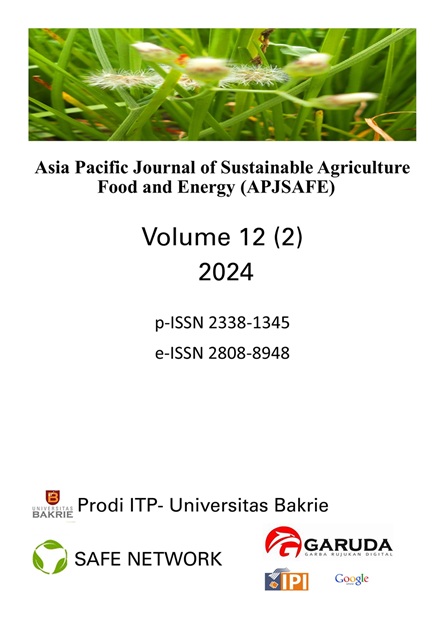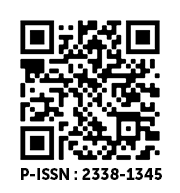Characterisation of mucilage extract of Paku Midin (Stenochlaena palustris)
DOI:
https://doi.org/10.36782/apjsafe.v12i2.408Keywords:
flavonoid, phenolic, phytochemical compounds, plant mucilage, S. palustris, UV-VisAbstract
Plant mucilage has a wide range of uses in the food industry. S. palustris is one of the wild plants containing mucilage, in addition, it also contains beneficial phytochemical compounds belonging to phenolic and flavonoid families. This study was conducted to determine the chemical composition of mucilage extract from S. palustris through phytochemical and physicochemical analysis, besides, determining the amount of mucilage extract yield at different maturity. The study design has two treatments, namely mucilage from young and mature leaves. Mucilage extraction is carried out using aqueous extraction technique. This research offers greater focus on specific physicochemical properties namely pH, color, and water holding capacity. The phytochemical of plant mucilages was measured using instrumental approaches of UV-Vis highlighting on phytochemical components like flavonoid and phenolic compounds. The results indicate mucilage extract of young leaves is higher than mature leaves. Meanwhile, physicochemical analysis data suggest the acid nature of mucilage is due to the presence of uronic acid, water holding capacity of mucilage from young leaves is higher than mature leaves, and each samples have obvious color differences. Phytochemical analysis reveals total phenolic content for young leaf mucilage was higher at 0.041 mg GAE/g ± 0.003, while total flavonoid content was higher in mature leaf mucilage at 0.166 mg CEQ/g ± 0.002. Overall, this study not only explains clear relationship between leaf maturity and mucilage production, but further on characterizing the physicochemical and phytochemical properties of mucilage extract from S. palustris for two different treatments.
Downloads
References
Añibarro-Ortega, Pinela, Barros, Ćirić, Silva, Coelho, Mocan, Calhelha, Soković, Coimbra, & Ferreira. 2019. Compositional features and bioactive properties of aloe vera leaf (fillet, mucilage, and rind) and Flower. Antioxidants, 8(10), 444. https://doi.org/10.3390/antiox8100444.
AOAC International. 2000. Official methods of analysis of aoac international. 17th edition. Gaithersburg: AOAC International.
Bakar, M. F. A., Mohamed, M., Rahmat, A., & Fry, J. 2009. Phytochemicals and antioxidant activity of different parts of bambangan (Mangifera pajang) and tarap (Artocarpus odoratissimus). Food chemistry, 113(2), 479-483.
Cakmak, H., Ilyasoglu-Buyukkestelli, H., Sogut, E., Ozyurt, V. H., Gumus-Bonacina, C. E., & Simsek, S. 2023. A review on recent advances of Plant Mucilages and their applications in food industry: Extraction, functional properties and health benefits. Food Hydrocolloids for Health, 3, 100131. https://doi.org/10.1016/j.fhfh.2023.100131.
Chear, N. J. Y., Khaw, K. Y., Murugaiyah, V., & Lai, C. S. 2016. Cholinesterase inhibitory activity and chemical constituents of Stenochlaena palustris fronds at two different stages of maturity. Journal of food and drug analysis, 24(2), 358-366.
Dai, F.-J., & Chau, C.-F. 2017. Classification and regulatory perspectives of dietary fiber. Journal of Food and Drug Analysis, 25(1), 37–42. https://doi.org/10.1016/j.jfda.2016.09.006.
Dash, G. K., & Hashim, Z. S. B. M. 2016. Pharmacognostic studies on Stenochlaena palustris (Burm. f) Bedd. Der Pharmacia Lettre, 8, 132-137.
Fan, L., Liu, Y., Huang, S., & Li, J. 2022. Effects of proteins on emulsion stability: The role of proteins at the oil–water interface. Food Chemistry, 133726.
Field, C. J., & Robinson, L. 2019. Dietary fats. Advances in Nutrition, 10(4), 722–724. https://doi.org/10.1093/advances/nmz052.
Forsido, S. F., Welelaw, E., Belachew, T., & Hensel, O. 2021. Effects of storage temperature and packaging material on physico-chemical, microbial and sensory properties and shelf life of extruded composite baby food flour. Heliyon, 7(4). https://doi.org/10.1016/j.heliyon.2021.e06821.
Ganogpichayagrai, A., & Suksaard, C. 2020. Proximate composition, vitamin and mineral composition, antioxidant capacity, and anticancer activity of Acanthopanax trifoliatus. Journal of Advanced Pharmaceutical Technology & Research, 11(4), 179. https://doi.org/10.4103/japtr.japtr_61_20.
Hassan, I., Gani, A., Ahmad, M., & Banday, J. 2022. Extraction of polysaccharide from Althea rosea and its physicochemical, anti-diabetic, anti-hypertensive and antioxidant properties. Scientific Reports, 12(1), 17116.
Ismail, B. P. 2017. Ash content determination. Food Analysis Laboratory Manual, 117–119. https://doi.org/10.1007/978-3-319-44127-6_11.
Julie, H. E., Sanah, A., & Andrew, M. 2023. Physiology, carbohydrates - statpearls - NCBI bookshelf. National Library of Medicine. [Online]. https://www.ncbi.nlm.nih.gov/books/NBK459280/. (11 September 2023).
Kaur, M., Kaur, R., & Punia, S. 2018. Characterization of mucilages extracted from different flaxseed (Linum usitatissiumum L.) cultivars: A heteropolysaccharide with desirable functional and rheological properties. International journal of biological macromolecules, 117, 919-927.
Khandpur, R. S. 2019. pH Meter. [Online]. https://onlinelibrary.wiley.com/doi/abs/10.1002/9781119288190.ch285. (27 December 2023).
Kołton, A., Długosz-Grochowska, O., Wojciechowska, R., & Czaja, M. 2022. Biosynthesis regulation of folates and phenols in plants. Scientia Horticulturae, 291, 110561. https://doi.org/10.1016/j.scienta.2021.110561.
Kruk, J., Aboul-Enein, B. H., Duchnik, E., & Marchlewicz, M. 2022. Antioxidative properties of phenolic compounds and their effect on oxidative stress induced by severe physical exercise. The Journal of Physiological Sciences, 72(1). https://doi.org/10.1186/s12576-022-00845-1.
Mattioli, R., Francioso, A., Mosca, L., & Silva, P. 2020. Anthocyanins: A comprehensive review of their chemical properties and health effects on cardiovascular and neurodegenerative diseases. Molecules, 25(17), 3809.
Ma, Z. Q., Zhang, N., Zhai, X. T., & Tan, B. 2023. Structural, physicochemical and functional properties of dietary fiber from brown rice products treated by different processing techniques. LWT, 182, 114789.
Mukherjee, T., Lerma‐Reyes, R., Thompson, K. A., & Schrick, K. 2019. Making glue from seeds and gums: Working with plant‐based polymers to introduce students to plant biochemistry. Biochemistry and Molecular Biology Education, 47(4), 468–475.
Naikoo, M. I., Dar, M. I., Raghib, F., Jaleel, H., Ahmad, B., Raina, A., Khan, F. A., & Naushin, F. 2019. Role and regulation of plants phenolics in abiotic stress tolerance. Plant Signaling Molecules, 157–168. https://doi.org/10.1016/b978-0-12-816451-8.00009-5.
Ndanusa, A. H., Cicuzza, D., & Siddique, M. M. 2020. Analysis of the phytochemical contents and anti-oxidative properties of Stenochlaena palustris. International Food Research Journal, 27(5), 798-804.
Oh, S., & Kim, D.-Y. 2022. Characterization, antioxidant activities, and functional properties of mucilage extracted from Corchorus Olitorius L. Polymers, 14(12), 2488. https://doi.org/10.3390/polym14122488
Pandiangan, F. I., Oslo, E. A., Destine, F., Josephine, J., & Anwar, R. N. 2022. A review on the health benefits of Kalakai (stenochlaena palustris). Journal of Functional Food and Nutraceutical, 4(1), 1–16. https://doi.org/10.33555/jffn.v4i1.98
Pan, Y., Li, H., Chen, X., Fan, Y., Zhang, B., Liu, R., & Deng, Z. 2022. Antioxidant interactions between hydrophilic and lipophilic phytochemicals are influenced by their ratios and total concentrations. Food Bioscience, 45, 101465. https://doi.org/10.1016/j.fbio.2021.101465.
Patle, T. K., Shrivas, K., Kurrey, R., Upadhyay, S., Jangde, R., & Chauhan, R. 2020. Phytochemical screening and determination of phenolics and flavonoids in Dillenia pentagyna using UV–vis and FTIR spectroscopy. Spectrochimica Acta Part A: Molecular and Biomolecular Spectroscopy, 242, 118717.
Royani, A., Hanafi, M., Julistiono, H., & Manaf, A. 2023. The total phenolic and flavonoid contents of Aloe vera and Morinda citrifolia extracts as antibacterial material against Pseudomonas aeruginosa. Materials Today: Proceedings, 72, 2796-2802.
Shen, Y., Hong, S., & Li, Y. 2022. Pea protein composition, functionality, modification, and food applications: A review. Advances in food and nutrition research, 101, 71-127.
Shomali, A., Das, S., Arif, N., Sarraf, M., Zahra, N., Yadav, V., Aliniaeifard, S., Chauhan, D. K., & Hasanuzzaman, M. 2022. Diverse physiological roles of flavonoids in plant environmental stress responses and tolerance. Plants, 11(22), 3158. https://doi.org/10.3390/plants11223158.
Soares‐da‐Silva, F. A., Campos, F. M., Ferreira, M. L., Ribeiro, N., Amaral, B., Simões, T., & Silva, C. L. 2019. Colour profile analysis of port wines by various instrumental and visual methods. Journal of the Science of Food and Agriculture, 99(7), 3563-3571.
Sosulski, F., Humbert, E. S., Bui, K., & Jones, J. D. 1976. Functional properties of rapeseed flours, concentrates and isolate. Journal of Food Science. 41(6): 1349-1352.
Tosif, M. M., Najda, A., Bains, A., Kaushik, R., Dhull, S. B., Chawla, P., & Walasek Janusz, M. 2021. A comprehensive review on plant-derived mucilage: Characterization, functional properties, applications, and its utilization for Nanocarrier Fabrication. Polymers, 13(7), 1066.
Xie, C., Li, J., Pan, F., Fu, J., Zhou, W., Lu, S., Li, P., & Zhou, C. 2018. Environmental factors influencing mucilage accumulation of the endangered Brasenia Schreberi in China. Scientific Reports, 8(1). https://doi.org/10.1038/s41598-018-36448-3.
Xu, Y. 2017. Hierarchical materials. Modern Inorganic Synthetic Chemistry, 545–574.
Yan, T. H., Lim, P. X., Hui-Zi, L., Mikal, K. M., Saupi, N., Kamaludeen, J., & Sarbini, S. R. 2022. Preliminary evaluation of Midin (Stenochlaena palustris), the edible fern of Sarawak, Malaysia as a potential prebiotic ingredient. In e-Proceeding 2nd International Scientific Conference on Indigenous Crops (p. 87).
Downloads
Published
How to Cite
Issue
Section
License
Copyright (c) 2024 Ernielyn Wilfred, Muhamad Hanif Rawi

This work is licensed under a Creative Commons Attribution 4.0 International License.








